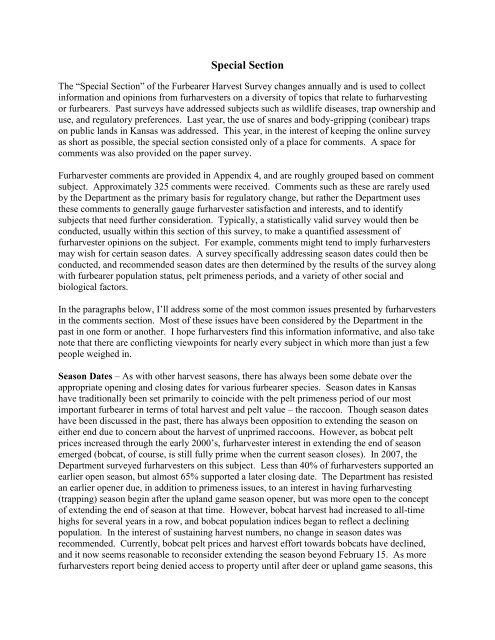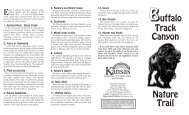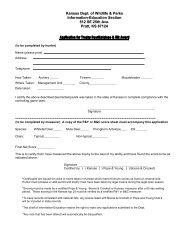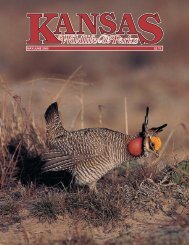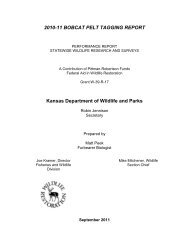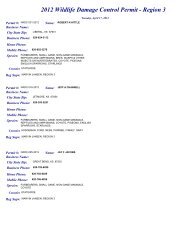2009-10 Furbearer Harvest Survey Report - Kansas Department of ...
2009-10 Furbearer Harvest Survey Report - Kansas Department of ...
2009-10 Furbearer Harvest Survey Report - Kansas Department of ...
Create successful ePaper yourself
Turn your PDF publications into a flip-book with our unique Google optimized e-Paper software.
Special Section<br />
The “Special Section” <strong>of</strong> the <strong>Furbearer</strong> <strong>Harvest</strong> <strong>Survey</strong> changes annually and is used to collect<br />
information and opinions from furharvesters on a diversity <strong>of</strong> topics that relate to furharvesting<br />
or furbearers. Past surveys have addressed subjects such as wildlife diseases, trap ownership and<br />
use, and regulatory preferences. Last year, the use <strong>of</strong> snares and body-gripping (conibear) traps<br />
on public lands in <strong>Kansas</strong> was addressed. This year, in the interest <strong>of</strong> keeping the online survey<br />
as short as possible, the special section consisted only <strong>of</strong> a place for comments. A space for<br />
comments was also provided on the paper survey.<br />
Furharvester comments are provided in Appendix 4, and are roughly grouped based on comment<br />
subject. Approximately 325 comments were received. Comments such as these are rarely used<br />
by the <strong>Department</strong> as the primary basis for regulatory change, but rather the <strong>Department</strong> uses<br />
these comments to generally gauge furharvester satisfaction and interests, and to identify<br />
subjects that need further consideration. Typically, a statistically valid survey would then be<br />
conducted, usually within this section <strong>of</strong> this survey, to make a quantified assessment <strong>of</strong><br />
furharvester opinions on the subject. For example, comments might tend to imply furharvesters<br />
may wish for certain season dates. A survey specifically addressing season dates could then be<br />
conducted, and recommended season dates are then determined by the results <strong>of</strong> the survey along<br />
with furbearer population status, pelt primeness periods, and a variety <strong>of</strong> other social and<br />
biological factors.<br />
In the paragraphs below, I’ll address some <strong>of</strong> the most common issues presented by furharvesters<br />
in the comments section. Most <strong>of</strong> these issues have been considered by the <strong>Department</strong> in the<br />
past in one form or another. I hope furharvesters find this information informative, and also take<br />
note that there are conflicting viewpoints for nearly every subject in which more than just a few<br />
people weighed in.<br />
Season Dates – As with other harvest seasons, there has always been some debate over the<br />
appropriate opening and closing dates for various furbearer species. Season dates in <strong>Kansas</strong><br />
have traditionally been set primarily to coincide with the pelt primeness period <strong>of</strong> our most<br />
important furbearer in terms <strong>of</strong> total harvest and pelt value – the raccoon. Though season dates<br />
have been discussed in the past, there has always been opposition to extending the season on<br />
either end due to concern about the harvest <strong>of</strong> unprimed raccoons. However, as bobcat pelt<br />
prices increased through the early 2000’s, furharvester interest in extending the end <strong>of</strong> season<br />
emerged (bobcat, <strong>of</strong> course, is still fully prime when the current season closes). In 2007, the<br />
<strong>Department</strong> surveyed furharvesters on this subject. Less than 40% <strong>of</strong> furharvesters supported an<br />
earlier open season, but almost 65% supported a later closing date. The <strong>Department</strong> has resisted<br />
an earlier opener due, in addition to primeness issues, to an interest in having furharvesting<br />
(trapping) season begin after the upland game season opener, but was more open to the concept<br />
<strong>of</strong> extending the end <strong>of</strong> season at that time. However, bobcat harvest had increased to all-time<br />
highs for several years in a row, and bobcat population indices began to reflect a declining<br />
population. In the interest <strong>of</strong> sustaining harvest numbers, no change in season dates was<br />
recommended. Currently, bobcat pelt prices and harvest effort towards bobcats have declined,<br />
and it now seems reasonable to reconsider extending the season beyond February 15. As more<br />
furharvesters report being denied access to property until after deer or upland game seasons, this


